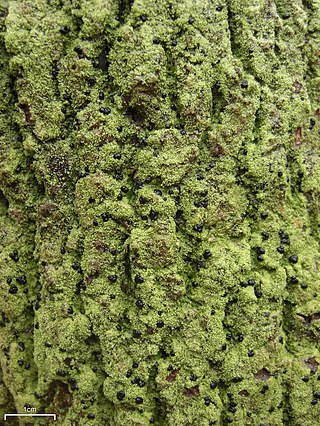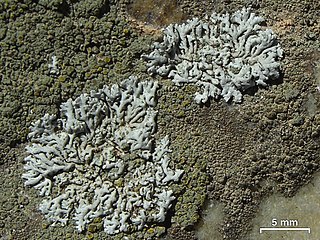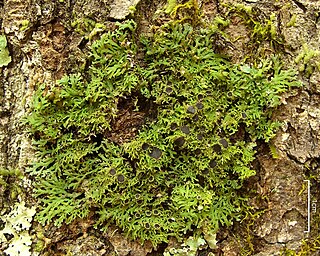
Chaenotheca is a genus of lichenized fungi within the family Coniocybaceae. The sexual reproduction structures are a mass of loose ascospores that are enclosed by a cup shaped exciple sitting on top of a tiny stalk, having the appearance of a dressmaker's pin, hence the common name pin lichen. Genus members are also commonly called needle lichens. Photobiont partners for Chaenotheca include members of the algae genera Symbiochloris, Trebouxia, Trentepohlia, and Tritostichococcus.

The Lecanorales are an order of mostly lichen-forming fungi belonging to the class Lecanoromycetes in the division Ascomycota. The order contains 26 families, 269 genera, and 5695 species.

Bacidia is a genus of lichen-forming fungi in the family Ramalinaceae. The genus was circumscribed by Giuseppe De Notaris in 1846.

Chaenothecopsis is a genus of about 40 species of pin lichens in the family Mycocaliciaceae.

Haematomma ochroleucum, also known as yellow bloodstain lichen, is a species of crustose lichenized fungus. First described in 1771 by Noël Martin Joseph de Necker, it has no subspecies, but two named varieties: H. o. var. ochroleucum and H. o. var. porphyrium.
Lepidocollema wainioi is a species of lichen in the family Pannariaceae. It is known from southeast Asia.
Chaenothecopsis dibbleandersoniarum is a species of fungus in the family Mycocaliciaceae. It was described as new to science in 2003 by Steve Selva, from samples collected on Cape Breton Island, Nova Scotia, Canada. It has also been recorded in Maine. The fungus is lichenicolous, and grows as a parasite on the apothecia and thallus of the lichen Arthonia leucopellaea. It is named after Dr. Alison Dibble and Ms. Frances Anderson, both of whom independently brought the species to the attention of Selva.

Candelariella antennaria, or the pussytoes eggyolk lichen, is a lichen commonly distributed in North America, and has been observed in South America, Asia, Australia, and Europe. It is characterized by its gray thallus and bright yellow apothecia, as well as its very small size.

Punctelia bolliana, the eastern speckled shield lichen, is a species of foliose lichen in the family Parmeliaceae. It is found in North America, with a distribution extending from the Canadian province of Ontario south to the central and northeastern United States and Mexico. It grows on the bark of both deciduous trees and coniferous trees. The combination of characteristics that distinguishes this species from others in genus Punctelia are the absence of the vegetative propagules isidia and soralia, a pale brown lower thallus surface, and the presence of the secondary chemical protolichesterinic acid in the medulla.
Calycidium is a genus of lichen-forming fungi in the family Sphaerophoraceae. It has two species. It is one of the few lichen genera containing foliose (leafy) species that produce a mazaedium – a powdery mass of spores. Both species occur in Australasia and South America, where they grow on tree bark or on mosses.
Strangospora is a genus of lichen-forming fungi. It is the only genus in the family Strangosporaceae, which itself is of uncertain taxonomic placement in the Ascomycota. It contains 10 species.
Amazonotrema is a monotypic genus of lichenised fungi in the family Graphidaceae. It was circumscribed in 2009 by Klaus Kalb and Robert Lücking for the species Amazonotrema nigrum. The type specimen of A. nigrum was collected from virgin rainforest along the Rio Negro in the Brazilian state of Amazonas.
Phlyctis lueckingii is a species of corticolous (bark-dwelling) lichen in the family Phlyctidaceae. Found in Sri Lanka, it was formally described as a new species by Gothamie Weerakoon and André Aptroot in 2016. The type was collected on the Dothalugala mountain, where it was found in a rainforest on the smooth bark of a tree. The species epithet honours lichenologist Robert Lücking.
Helocarpaceae is a family of lichen-forming fungi in the subclass Lecanoromycetidae. The family is monotypic, and contains the single genus Helocarpon.
Physcia rhizinata is a species of corticolous (bark-dwelling), lichenized fungus in the family Physciaceae. It is a "typically fertile species lacking asexual propagules" commonly mistaken for P. stellaris due to their physical similarities. It has a close evolutionary relationship with P. occidentalis despite being morphologically dissimilar.
Phlyctis sirindhorniae is a little-known species of corticolous (bark-dwelling), crustose lichen in the family Phlyctidaceae. It shares some similarities with Phlyctis agelaea but can be distinguished by its smaller ascospores, larger apothecia, and a higher number of ascospores per ascus. It is only known to exist in a specific location in northeastern Thailand.

Kurokawia palmulata, the shaggy fringe lichen, is a species of corticolous (bark-dwelling), foliose lichen in the family Physciaceae.

Coniocarpon is a genus of lichen-forming fungi in the family Arthoniaceae. It has eight species of corticolous (bark-dwelling) lichens. This genus is distinct for its crystalline orange, red, and purple quinoid pigments in the ascomata that turn purple in potassium hydroxide solution, its colourless, transversely septate ascospores with large apical cells, and its rounded to lirellate ascomata.
Chaenothecopsis jordaniana is a species of corticolous (bark-dwelling) pin lichen. Formally described as a new species in 2020 by Otto Gockman and Steven Selva, it is classified in the family Mycocaliciaceae.
Caloplaca edwardiana is a species of lichen-forming fungus in the family Teloschistaceae. It was described as new to science in 2019 by Jordan Hoffman and James Lendemer. It has been found in the southern Appalachian Mountains of eastern North America; more specifically, Alabama, Georgia, and Tennessee.








